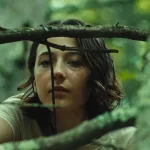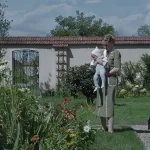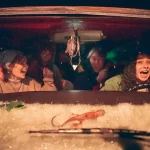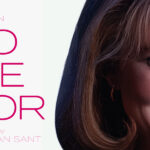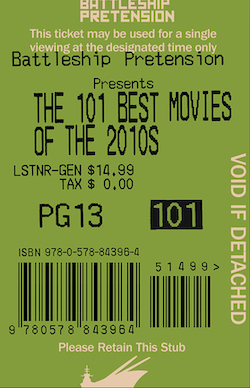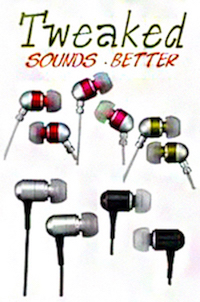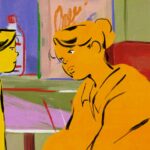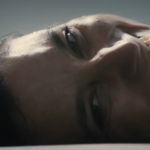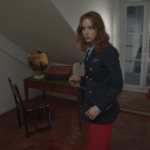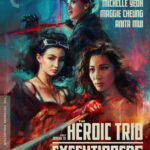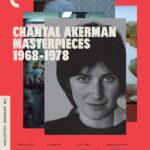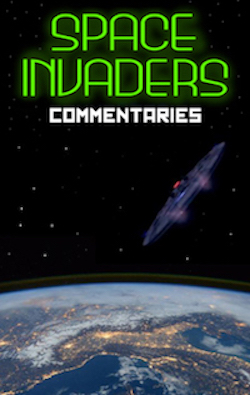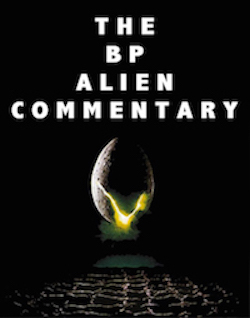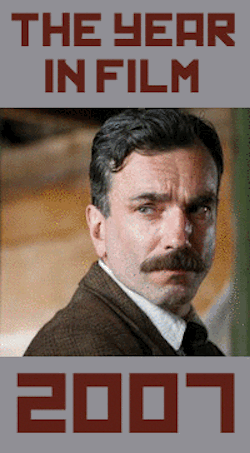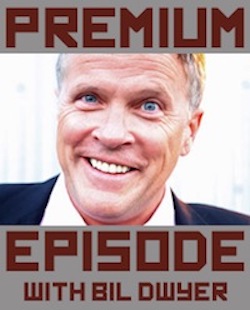Sundance 2015 Part Three, by Matt Warren
So here we are: Day Three of my annual Sundance sojourn. Did you ever see that episode of Star Trek: The Next Generation where Captain Picard is zapped by a comet or whatever and somehow lives an entire lifetime inside his mind within the blink of an eye? That’s kind of where I’m at right now. Much like time itself, Sundance is a flat circle. I don’t remember my life before this film festival, and I can’t imagine an existence outside of it. Like, what does my wife’s face look like? Is the President still black? And really, what are horses for? Who knows. The mind simultaneously expands and collapses along parallel inter-dimensional railway tracks. I look into the mirror and my face distorts. Reality and fiction blur into a shapeless cloud of TV static—which is apropos, since Day Three was all about documentaries. Some might even deem it a real #AllDocEverything. So prove to me that you know how to read and see what I have to say about this diverse slate of nonfiction watch-‘em-ups. And don’t think I can’t feel your eyeballs on the page, so go! Now, now, now!
Western
Vérité documentaries can be a dicey proposition. Obviously there’s always some degree of editorializing inherent to movie-making regardless of how dispassionate or objective the filmmakers attempt to approach their subjects. Really, the whole thesis of vérité is flawed—it’s more of an aesthetic than an ethical approach. And when you remove the ability to utilize storytelling tools such as interviews, voiceover, and infographics, you’re banking on the hope that your raw content will be interesting enough to sustain a feature film, and that your cameras will be present when remarkable shit goes down. In both regards, the border town narco-cartel saga Western is…okay. Directed by the presumably related duo of Bill Ross and Turner Ross, Western is a boots-on-the-ground document of life along the Texas/Mexico border as experienced through the eyes of two men: Chad Foster, the charismatic progressive mayor of the stateside hamlet of Eagle Pass, TX, and Martín Wall, a hardworking cattle broker and dotting single father of a young daughter. Life complicates for both as cartel violence increases south of the border, first in nearby Acuña, then inching toward Piedras Negras, directly across from Eagle Pass on the Mexican side of the Rio Grande. But while stories of shootouts, murders, kidnappings, and other such mayhem are much discussed, Ross & Ross eschew (or fail to capture) any such drama onscreen, focusing instead on smaller world-building moments like the process of cattle branding, bull fights, and phoning up unregistered voters. It’s interesting enough, but Foster and Wall are both such taciturn and well-guarded individuals that there’s no real emotional inroad to their experience of these events. Western is plenty educational, but it has more in common with journalism than it does with cinema.
The Beaver Trilogy, Part IV
Okay, this is going to be a difficult one to discuss. This, for three reasons: 1) because the premise of this documentary is sort of convoluted and difficult to explain, 2) because I actually have a personal connection to the film’s subject IRL, and 3) because it provoked a very intense emotional response in me for reasons that may or may not be related to 2) and that are, in any event, difficult to understand or articulate. But let’s try. Directed by Utah’s own Brad Besser, The Beaver Trilogy, Part IV is first and foremost a profile of Salt Lake City indie film rebel Trent Harris. If you don’t know who Trent Harris is—and you don’t—the best way to explain is that he’s sort of like Salt Lake City’s answer to John Waters except much, much, much less successful. Trent is also a personal family friend, as well as someone who I’ve drawn a lot of inspiration from in my own less-than-world-beating attempts to put my mark on the entertainment industry. In the late-‘70s/early-‘80s, he and my parents (both of ‘em) worked together as segment producers at Extra, a renowned local newsmagazine program that showed on Utah’s KUTV Channel 2. One day while shooting test footage with the station’s new video camera, Trent stumbled upon Richard Griffiths, aka “Groovin’ Gary”, in the KUTV parking lot taking pictures of the channel’s news helicopter. Trent was immediately captivated by the young man’s enthusiasm, chutzpah, and “aw shucks” fascination with showbiz. He followed the kid back to his rural Beaver, UT hometown, where Griffiths staged an impromptu talent show, taking the stage in full wig and mortician-applied makeup as his drag persona “Olivia Newton-Dawn.” The resulting 20-minute documentary short was then shelved, seemingly never to be seen again. Trent later left Salt Lake for Hollywood, where he remade what he now called The Beaver Kid as a scripted short. In this version, Groovin’ Gary was played by an unknown, pre-Fast Time at Ridgemont High Sean Penn. Trent then remade the film again as an AFI senior thesis, this time with a pre-Back to the Future Crispin Glover in the lead roll. All three versions where mothballed after post-production and never shown widely. Meanwhile, Trent crapped out of Hollywood and returned to Utah to resume (continue?) a life of frustrated starving-artistry. It was at the beginning of the 21st century that the three forgotten films were combined into The Beaver Trilogy, bringing Trent the greatest—and really, only—acclaim of his entire career, with rapturous write-ups in publications such as Spin and a segment devoted to the film on This American Life. But Trent always felt conflicted about the film’s success, as did Griffiths, who almost immediately felt embarrassed and exploited by what had happened in Beaver that fateful day in 1979, retreating deep into himself and dying of a heart attack at age 50. The Beaver Triology, Part IV follows all of these threads and more with style, wit, and slick production, including voiceover narration from none other than SNL’s Bill Hader. It’s a fascinating, complicated, and deeply moving story, and I don’t think you need to know Trent personally for it to be effective. This was my favorite film of the festival by far, and I hope everyone gets to see it at some point. A must-see.
Fresh Dressed
After the turbulent emotional rollercoaster of The Beaver Trilogy, Part IV, I was looking forward to ending my day with something light and colorful. And for that, Fresh Dressed delivered. Directed by Sacha Jenkins for CNN Films, Dressed is a glossy, fast-paced, interview-heavy primer on the history of hip-hop clothing, from its handmade DIY origins in early-‘80s New York City to its ascendency as an international signifier of youth and urban cool. Jenkins snags screen time with plenty of high-profile artists, designers, business moguls, and fashion experts including Kanye West, Sean Combs, Marc Ecko, Riccardo Tisci, Andre Leon Talley, A$AP Rocky, Damon Dash, and more. It’s fun and colorful (literally!), but it’s all pretty basic. I imagine more finely-attuned connoisseurs of street fashion will find this take pretty superficial, but for dorky whites like yours truly it’s a good introduction and general overview of the scene, tracing the rise and fall of various stylistic and corporate trends with plenty of well-informed speculation as to what motivated each specific ebb and flow. It also seemed to be over almost as soon as it began despite a robust 90-minute runtime. If there’s a better indicator of a well-paced film, I don’t know what it is. Your closet may not be full of Cross-Colors, Fubu, Rocawear, or Mark Ecko, but if you have even a passing interest in hip-hop, fashion, business, and the intersection thereof, Fresh Dressed is well worth a watch. I’d be a good Netflix sit.
But seriously, why wouldn’t you just give the ball to Marshawn Lynch and have him just punch it in for the win? Mind-boggling. Oh well. That’s it for today. I’m back in California now, but we’ve got one more day to go. See you tomorrow for my final wrap-up.





